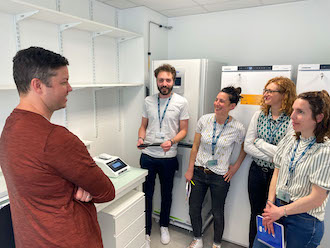Spectrophotometry is a cornerstone in teaching laboratories, especially in chemistry and biology. It involves the quantitative measurement of the reflection or transmission properties of a material as a function of wavelength. This technique is pivotal in determining the concentration of substances in a solution and understanding the principles of light absorption and transmission by chemical substances.
Teaching Approaches
- Interactive Models and Simulations: Interactive models and computer simulations are increasingly being used to simplify and elucidate the core concepts of spectrophotometry. These digital tools engage students effectively, making complex concepts more accessible and understandable.
- Hands-on Lab Activities: Practical lab activities using spectrophotometers are integral in teaching spectroscopy principles. They provide a tangible context for the application of theoretical knowledge, thereby enhancing understanding and retention.
Resources for Teaching
Educators have access to a plethora of resources for teaching spectrophotometry. This includes lab spectrophotometers, comprehensive lesson plans, educational videos, and webinars. UV-Vis spectrophotometers, designed explicitly for teaching labs, offer user-friendly features tailored to educational settings.
Benefits of Spectrophotometry in Teaching Labs
- Real-World Relevance: Highlighting the importance of spectrophotometry in diverse fields like research, medicine, environmental monitoring, and chemical manufacturing can significantly motivate students. It underscores the practical utility of what they learn in the classroom.
- Engaging Hands-On Activities: Lab activities using spectrophotometers help students understand the theoretical aspects of spectroscopy and its practical applications. These activities are crafted to provide comprehensive background material and ensure accurate results, making the learning process engaging and informative.
- Simplifying Core Concepts: Interactive models, simulations, and creative teaching methodologies help break down the complex concepts of spectrophotometry, making them more graspable for students.
- Understanding Instrumentation: Spectrophotometry facilitates a deep understanding of the workings of spectrophotometers at a fundamental level.
- Versatility and Ease of Use: Modern spectrophotometers are known for their versatility and user-friendly interfaces, making them suitable for various applications and easy to integrate into teaching environments.
Barriers to Teaching Spectrophotometry
- High Costs: The significant expense associated with spectrophotometric equipment can restrict access to quality hands-on learning experiences in many educational settings.
- Limited Access to Modern Equipment: The absence of state-of-the-art spectroscopy equipment in some institutions can impede the depth and quality of teaching spectrophotometry.
- Lack of Visibility into Instrumentation: Modern spectrophotometers, often designed as sealed units to protect their functionality, limit the opportunity for students to explore and understand the internal mechanics of these instruments visually.
- Barriers to Building Custom Instruments: While there are instances of educators and students creating homemade spectrophotometers, not all institutions possess the resources or expertise required for such endeavors.
- Differences in Equipment Models: Variability in spectrophotometer models across different educational settings can lead to laboratory teaching inconsistencies, potentially affecting instruction effectiveness.
Spectrophotometry is an essential component of the scientific curriculum in teaching labs, offering valuable insights into the interaction of light with matter. While it brings numerous benefits, such as real-world relevance and hands-on learning, educators face challenges like high costs and limited access to advanced equipment. Overcoming these barriers is crucial for providing students with a comprehensive and effective learning experience in spectrophotometry.
DeNovix’s Offerings in Teaching Labs
DeNovix presents cost-effective spectrophotometers like the DS-11+ Microvolume & Cuvette Spectrophotometer and the DS-C Cuvette Spectrophotometer, tailored for teaching labs. The DS-11, known for its compactness and simplicity, is ideal for rapid nucleic acid and protein quantification in microlitre volumes or traditional cuvettes. The DS-C is a versatile UV-Vis cuvette spectrophotometer, notable for its dynamic range and flexibility. Both models are equipped with EasyApps software for ease of use. Both instruments can combine UV-Vis absorbance with fluorescence measurements, offering flexibility and user-friendliness with a high-definition touchscreen interface and diverse connectivity options.
References
- Labster Blog. “5 Creative Ways to Teach Spectrophotometry with Spectrophotometers”. Available: [Labster](https://www.labster.com/blog/5-creative-ways-teach-spectrophotometry-spectrophotometers.
- Carolina Knowledge. “Four Engaging Lab Activities for Spectroscopy”. Available: [Carolina](https://knowledge.carolina.com/discipline/physical-science/chemistry/four-engaging-lab-activities-for-spectroscopy/).
- Royal Society of Chemistry. “Back to Basics with Spectrophotometry”. Available: [RSC Education](https://edu.rsc.org/ideas/back-to-basics-with-spectrophotometry/4012965.article).



